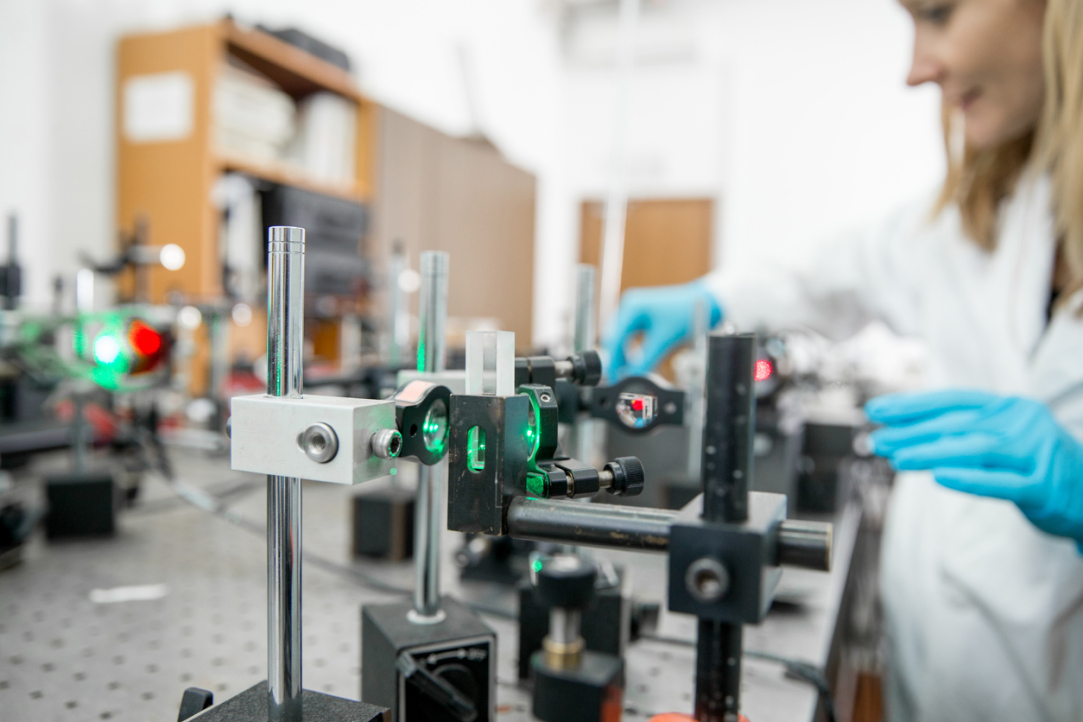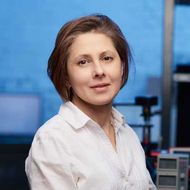Russian Scientists Integrate Microdisk Laser and Waveguide on a Single Substrate

A group of Russian scientists led by Professor Natalia Kryzhanovskaya at HSE Campus in St Petersburg has been researching microdisk lasers with an active region based on arsenide quantum dots. For the first time, researchers have successfully developed a microdisk laser coupled with an optical waveguide and a photodetector on a single substrate. This design enables the implementation of a basic photonic circuit on the same substrate as the radiation source (microlaser). In the future, this will help speed up data transfer and reduce equipment weight without compromising quality. The study results have been published in Semiconductors.
The growing demands for higher speed and larger volumes of transmitted information necessitate improvements to current communication methods. Photonic integrated circuits (PICs), which use light to transmit information, operate faster, generate less heat, are more resistant to interference, and consume less energy compared to their electronic counterparts.
However, their effective use requires efficient, compact light sources, such as gallium arsenide (GaAs) microdisk lasers. The length of a conventional Fabry–Perot laser is around 1 mm, while a microdisk laser can be up to 1,000 times smaller. In this study, the laser size was reduced to a diameter of 30 to 40 microns.
Effective directional radiation output is essential for the successful implementation of optical communication in photonic integrated circuits (PICs). Directional radiation can be achieved by optically coupling microlasers with a nearby waveguide. The authors of the paper designed and fabricated both a microlaser and a waveguide from a single epitaxial structure, resulting in reduced size and increased stability.
'Creating microdisk lasers coupled to a waveguide is a challenging task. This process involves developing a thin-film epitaxial structure with a specific composition. In our case, we employed gas-phase epitaxy of metal-organic compounds, a method for layered formation of crystals of different substances on top of one another. Lasers and waveguides were created from the resulting structure. This was made possible thanks to the innovations developed by the Mokerov Institute of Ultra High Frequency Semiconductor Electronics of the Russian Academy of Sciences. All these processes required the use of advanced technology and the efforts of a team of experienced, talented, and qualified specialists,' according to Nikita Fominykh, Junior Research Fellow of the International Laboratory of Quantum Optoelectronics at HSE Campus in St Petersburg.
In addition to radiation sources, radiation receivers are also essential for the operation of PICs. In this work, waveguide photodetectors fulfil this role. Thus, it becomes possible to create an optocoupler that combines a microlaser and a waveguide photodetector with a matching operating wavelength on a single substrate. The photodetector used in the optocoupler measured no more than 90 microns, enabling the creation of a highly compact and energy-efficient optocoupler.
'Microdisk lasers are unique optoelectronic devices. With a size comparable to the diameter of a spider silk thread, they can generate a significant amount of optical power. We have experimentally demonstrated that all optoelectronic components necessary for a photonic integrated circuit—a microdisk laser, a waveguide, and a photodetector—can be fabricated from a single epitaxial heterostructure on the same substrate,' says co-author of the paper Natalia Kryzhanovskaya, Head of the International Laboratory of Quantum Optoelectronics at HSE Campus in St Petersburg.
See also:
Scientists Test Asymmetry Between Matter and Antimatter
An international team, including scientists from HSE University, has collected and analysed data from dozens of experiments on charm mixing—the process in which an unstable charm meson oscillates between its particle and antiparticle states. These oscillations were observed only four times per thousand decays, fully consistent with the predictions of the Standard Model. This indicates that no signs of new physics have yet been detected in these processes, and if unknown particles do exist, they are likely too heavy to be observed with current equipment. The paper has been published in Physical Review D.
HSE Scientists Reveal What Drives Public Trust in Science
Researchers at HSE ISSEK have analysed the level of trust in scientific knowledge in Russian society and the factors shaping attitudes and perceptions. It was found that trust in science depends more on everyday experience, social expectations, and the perceived promises of science than on objective knowledge. The article has been published in Universe of Russia.
Scientists Uncover Why Consumers Are Reluctant to Pay for Sugar-Free Products
Researchers at the HSE Institute for Cognitive Neuroscience have investigated how 'sugar-free' labelling affects consumers’ willingness to pay for such products. It was found that the label has little impact on the products’ appeal due to a trade-off between sweetness and healthiness: on the one hand, the label can deter consumers by implying an inferior taste, while on the other, it signals potential health benefits. The study findings have been published in Frontiers in Nutrition.
HSE Psycholinguists Launch Digital Tool to Spot Dyslexia in Children
Specialists from HSE University's Centre for Language and Brain have introduced LexiMetr, a new digital tool for diagnosing dyslexia in primary school students. This is the first standardised application in Russia that enables fast and reliable assessment of children’s reading skills to identify dyslexia or the risk of developing it. The application is available on the RuStore platform and runs on Android tablets.
Physicists Propose New Mechanism to Enhance Superconductivity with 'Quantum Glue'
A team of researchers, including scientists from HSE MIEM, has demonstrated that defects in a material can enhance, rather than hinder, superconductivity. This occurs through interaction between defective and cleaner regions, which creates a 'quantum glue'—a uniform component that binds distinct superconducting regions into a single network. Calculations confirm that this mechanism could aid in developing superconductors that operate at higher temperatures. The study has been published in Communications Physics.
Neural Network Trained to Predict Crises in Russian Stock Market
Economists from HSE University have developed a neural network model that can predict the onset of a short-term stock market crisis with over 83% accuracy, one day in advance. The model performs well even on complex, imbalanced data and incorporates not only economic indicators but also investor sentiment. The paper by Tamara Teplova, Maksim Fayzulin, and Aleksei Kurkin from the Centre for Financial Research and Data Analytics at the HSE Faculty of Economic Sciences has been published in Socio-Economic Planning Sciences.
'Even among Geniuses, Luck Plays a Role in Winning a Nobel Prize'
Denis Bodrov studies particle physics and works at one of the four electron–positron colliders in the world. In this interview with the HSE Young Scientists project, he talks about his efforts to go beyond the Standard Model, discusses tau leptons, and shares his affection for Moscow.
Larger Groups of Students Use AI More Effectively in Learning
Researchers at the Institute of Education and the Faculty of Economic Sciences at HSE University have studied what factors determine the success of student group projects when they are completed with the help of artificial intelligence (AI). Their findings suggest that, in addition to the knowledge level of the team members, the size of the group also plays a significant role—the larger it is, the more efficient the process becomes. The study was published in Innovations in Education and Teaching International.
New Models for Studying Diseases: From Petri Dishes to Organs-on-a-Chip
Biologists from HSE University, in collaboration with researchers from the Kulakov National Medical Research Centre for Obstetrics, Gynecology, and Perinatology, have used advanced microfluidic technologies to study preeclampsia—one of the most dangerous pregnancy complications, posing serious risks to the life and health of both mother and child. In a paper published in BioChip Journal, the researchers review modern cellular models—including advanced placenta-on-a-chip technologies—that offer deeper insights into the mechanisms of the disorder and support the development of effective treatments.
Using Two Cryptocurrencies Enhances Volatility Forecasting
Researchers from the HSE Faculty of Economic Sciences have found that Bitcoin price volatility can be effectively predicted using Ethereum, the second-most popular cryptocurrency. Incorporating Ethereum into a predictive model reduces the forecast error to 23%, outperforming neural networks and other complex algorithms. The article has been published in Applied Econometrics.




